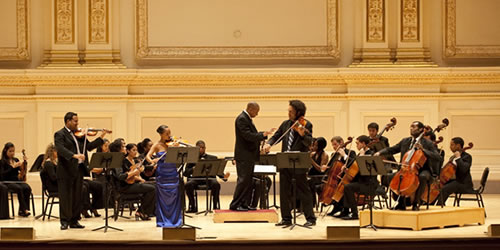
T he ensemble, conducted by Damon Gupton, opened its program with a shimmering, lovingly-shaped reading of Sibelius’s ‘Andante Festivo’. All the hallmarks of a first-rate string ensemble were in place: its tone was warm and varied, it moved with unity and fluidity, and its textures were appealingly transparent.”T he inaugural program of the new Alliance between Friends of Chamber Music and the UMKC Conservatory of Music and Dance occurred yesterday afternoon—a concert by Sphinx Chamber Orchestra and the Harlem Quartet.
— Allan Kozinn, New York Times, 06-OCT-2010.
S phinx was founded in 1996 by Aaron Dworkin, a violinist, and is based in Detroit. It is dedicated to developing young black and Hispanic classical musicians and composers, providing instruments, scholarships, and support. The SCO is a 20-piece chamber orchestra, widely acclaimed for its precise and passionate playing, conducted by Damon Gupton (previously Assistant Conductor of Kansas City Symphony and winner of the 2007 Eduardo Mata International Conducting Competition, the Robert J. Harth Conducting Prize, and other awards). The Harlem Quartet is comprised of Sphinx alumni Ilmar Gavilán (violin), Melissa White (violin), Juan-Miguel Hernandez (viola), and Paul Wiancko (cello).
- Jean Sibelius – Andante festivo (1922)
- Sergei Prokofiev – Allegro con brio (from Sonata for 2 violins, Op. 56, 1932) [Elena Urioste and Melissa White]
- Gabriela Lena Frank – Coquetos (2001) [from ‘Leyendas’]
- George Walker – Lyric for Strings (1946)
- Joaquin Turina – La oración del torero, Op. 34 (1925) [Harlem Quartet]
- Frederick Tillis – ‘Wade in the Water’ (from Spiritual Fantasy No. 12, 1988) [Harlem Quartet]
- Felix Mendelssohn – Sinfonia No. 7 in D minor (1822)
- Coleridge-Taylor Perkinson – Allegro furioso (from Sinfonietta No. 1, 1953)
P rograms like this help to insure that the Arts are available, not just to a few, but to everyone.”T he entire concert was exceptionally good and received an enthusiastic standing ovation at its conclusion. It’s not my habit in this blog to do ‘reviews’ per se, but I particularly loved the Prokofiev violin duo and can’t help but say a few words about that.
— Peter Witte, Dean, UMKC Conservatory of Music and Dance.
 T his fourth movement, the Allegro con brio, is a fast rondo with athletic, angular, in-your-face themes for the two violins. Urioste and White were a tour de force, spirited and incisive. I had previously heard Urioste perform in 2007 when she was completing her studies at Curtis Institute of Music in Philadelphia. I’d previously heard White when she was at New England Conservatory in Boston. It was a delight to hear these two perform together; to recalibrate my recollections and impressions from several years ago; and to experience their pyrotechnical interactions with each other in this challenging, aggressive piece.
T his fourth movement, the Allegro con brio, is a fast rondo with athletic, angular, in-your-face themes for the two violins. Urioste and White were a tour de force, spirited and incisive. I had previously heard Urioste perform in 2007 when she was completing her studies at Curtis Institute of Music in Philadelphia. I’d previously heard White when she was at New England Conservatory in Boston. It was a delight to hear these two perform together; to recalibrate my recollections and impressions from several years ago; and to experience their pyrotechnical interactions with each other in this challenging, aggressive piece. 
P rokofiev left his homeland for the West six months after the 1917 Russian Revolution and did not see it again until 1927, when he returned for a concert tour. A second tour followed in 1929, and a third, in 1932, marked the beginning of his gradual—and entirely voluntary—repatriation, which was completed by 1936. Just before that 1932 visit he composed his ‘Sonata for Two Violins’ during a holiday at Ste. Maxime (near St. Tropez) for performance in the concerts of the Paris chamber music group called Triton. The four brief movements, which Svyatoslav Prokofiev, the composer’s son, characterized as being ‘lyrical, playful, fantastical, and violent in turn,’ are filled with striking themes. The highly effective sequence apparently reflects the format of the old ‘sonata da chiesa’, and the content gives a fairly clear indication of the warmer style Prokofiev would adopt after his wanderings in the West, increasingly more ‘embracing’ rather than ‘biting’ or confrontational...”I n this mid-term election season in the U.S. that is nothing if not biting or confrontational, Urioste and White provided a welcome antidote. Their playing embodied a politically active, assertive, insightful tone. Embracing, never bellicose or grizzly bear-like. Their playing conveyed a sense of optimism that fair compromise can be achieved, with shared resolve to forge that compromise right away. “Here is how we do it! Here! Listen!”
— Richard Freed, Program Note, Kennedy Center, 2004.
T heir performance was redemptive—enough to inspire hope for this country’s future, in dimensions far beyond Sphinx, far beyond serious music.
I n conclusion, congratulations to SCO and Harlem Quartet on their tour, and on their luminous performance in Kansas City yesterday. Heartfelt thanks to SCO and Harlem Quartet for their leadership, and for their generous outreach activities that help so many young students. Bravo!

- Sphinx Chamber Orchestra website
- Sphinx Chamber Orchestra 2010 tour blog
- Harlem Quartet webpage at Sciolino Artist Management
- Elena Urioste website
- Coleridge-Taylor Perkinson page at AfriClassical.com
- Prokofiev Sonata for Two Violins, Op. 56, at prokofiev.org
- Prokofiev Sonata for Two Violins, Op. 56, at IMSLP (download blocked in U.S. [copyright])
- Prokofiev Sonata for Two Violins, Op. 56, at SheetMusicPlus.com
No comments:
Post a Comment